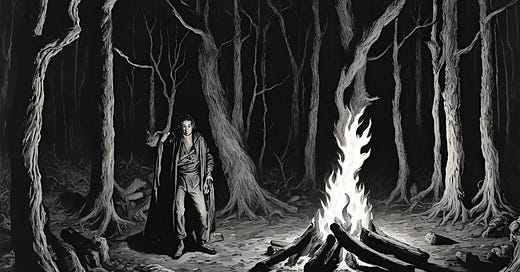Today, we delve into a tale so dark, so disturbing, that it has chilled the blood of generations: the legend of Sawney Bean, the alleged cannibal who terrorised the Scottish coast in the 16th century. This isn't your average ghost story; this is a story of purported real-life horror, a chilling reminder of the darkness that can exist within humanity.
Our tale unfolds in 16th-century Scotland, a land of rugged landscapes and even more rugged inhabitants. Alexander Beane, who would become known as Sawney, was born in East Lothian, the son of a laborer. Legend paints him as a shiftless youth, averse to hard work and drawn to the allure of petty theft. He quickly discovered that crime offered a far easier path to riches than honest labor, and his activities soon escalated from simple thievery to violent robbery.
Sawney’s partner in crime, and in life, was Agnes Douglas, a woman whose fiery temper and rumored association with witchcraft made her an outcast in her village. Black Agnes, as she was known, was Sawney’s perfect match. They wed and embarked on a life of crime together, their activities growing increasingly bold and brutal.
Unlike most bandits, who might show some degree of mercy or spare a life in exchange for valuables, Sawney and Agnes were utterly ruthless. They robbed and murdered their victims without hesitation, leaving no witnesses to their gruesome deeds. The Scottish countryside, even in those lawless times, was shocked by the sheer savagery of their crimes. It's said they often used Agnes as bait, a lone woman in distress luring unsuspecting travelers into their deadly trap.
The disappearances mounted, creating a climate of fear. People were afraid to travel, and trade suffered. But the bodies were rarely found, and the authorities were baffled. Sawney and Agnes, meanwhile, developed a taste for human flesh. Cannibalism became a regular part of their diet, a horrifying secret that remained hidden for decades.
As their crimes grew more frequent, Sawney and Agnes needed a permanent hideout. They found it on the coast of the Firth of Clyde, near Girvan. A dark, damp, and forbidding cave, cut off by the tide twice a day, became their lair. It was a perfect refuge, remote, defensible, and ideal for concealing their gruesome activities.
The disappearances continued, now spanning a wider area. Rumors of mutilated remains washing ashore, some bearing the gnaw marks of small teeth, added to the growing terror. King James VI, a superstitious monarch, ordered an investigation, but his agents were unsuccessful. They either searched in the wrong places or vanished themselves, perhaps becoming victims of the very evil they sought to uncover.
The Bean clan, as it had now grown, operated with chilling efficiency. They no longer targeted lone travelers but ambushed small groups, sometimes using their numerous children – described as having "grubby faces, torn clothes and bright, hungry eyes" – as decoys. The victims were dragged back to the cave, butchered, and either eaten on the spot or preserved for later consumption. They pickled some of the flesh in jars, and smoked and salted the rest over small fires within the cave.
For decades, the Bean clan thrived, their gruesome secret hidden in the depths of their cave. But their reign of terror was about to meet its end.
One fateful big market day in Girvan, one of several held throughout the year, a young couple, engaged to be married, set out for a nearby village. They were ambushed by the Bean clan, but the young man was no ordinary traveler. He was a cavalry officer, and he fought back with the ferocity of a cornered animal.
Armed with a pistol, he wounded one of the attackers, and with his sabre, he managed to fight his way towards his fiancé, raising the alarm. Though his fiancé was killed in the brutal melee, his actions exposed the horrific truth to the terrified townspeople.
The hunt for the Bean clan was swift and decisive. A large party, accompanied by bloodhounds, tracked them to their cave. The scene within was a nightmare made real: body parts littered the floor, bones piled high, and jars of pickled human flesh lining the walls. Forty-eight members of the Bean clan, from Sawney and Agnes to their numerous descendants, were captured.
The Beans were taken to Edinburgh and, deemed to be beyond humanity, were denied a trial. One version of the story says they were sealed in their cave and left to suffocate. Another, more gruesome account, states that the men were subjected to a gruesome public execution, their genitals and limbs severed before being left to bleed to death. The women and children were then tied to stakes and burned alive. Amidst the screams and wails, Sawney Bean’s defiant last words echoed: “It’s not over, it will never be over!”
The legend of Sawney Bean has endured for centuries, a chilling reminder of the darkness that can lurk in the human heart. Whether the story is entirely true or embellished over time, it serves as a powerful cautionary tale and a testament to the enduring fascination with the macabre. What do you think? Is it a true account, or a heavily embellished legend? Let us know in the comments below!
For our full podcast on Sean Sawney Bean check out episode 21 of Wyrd Wessex here
Or watch here



